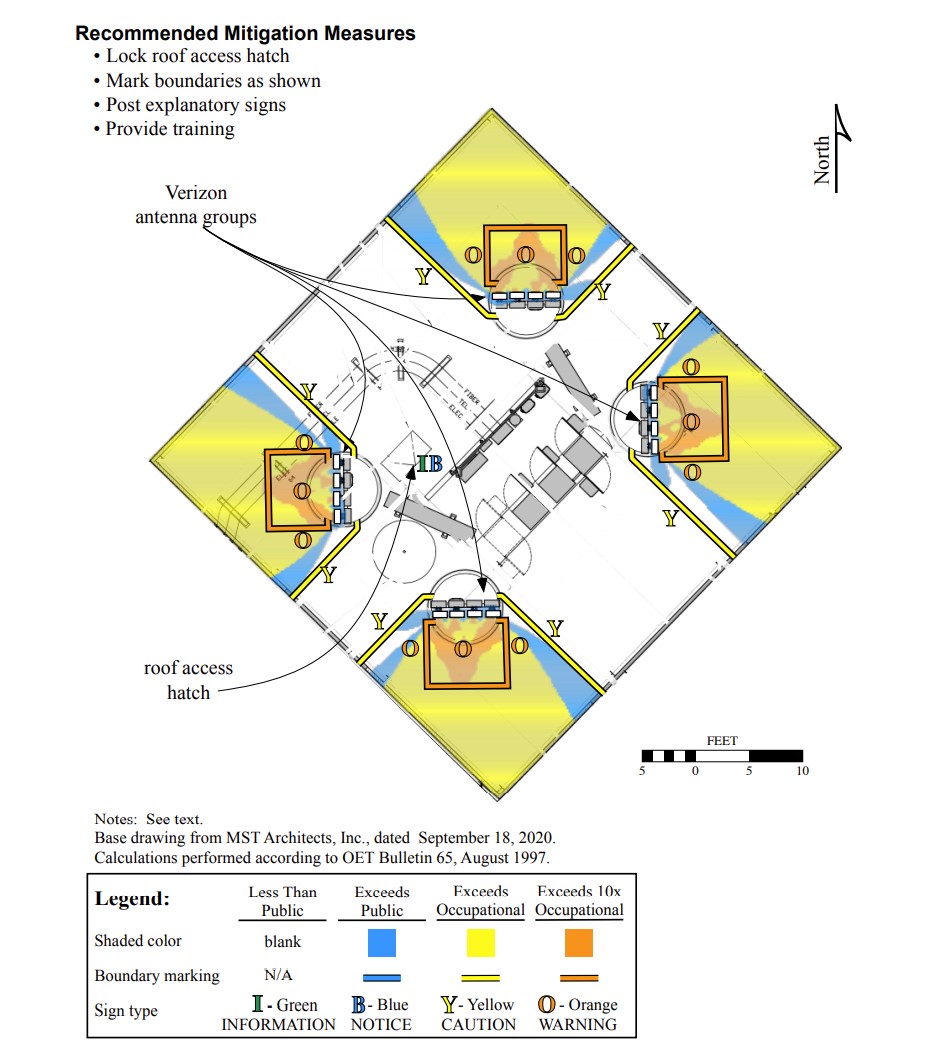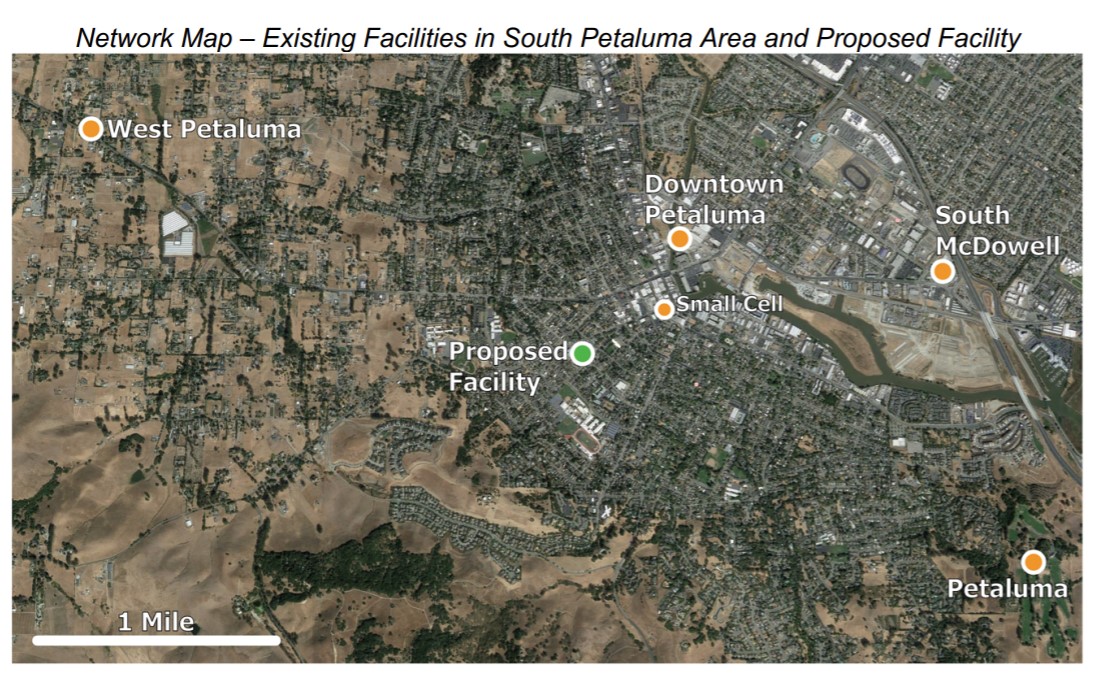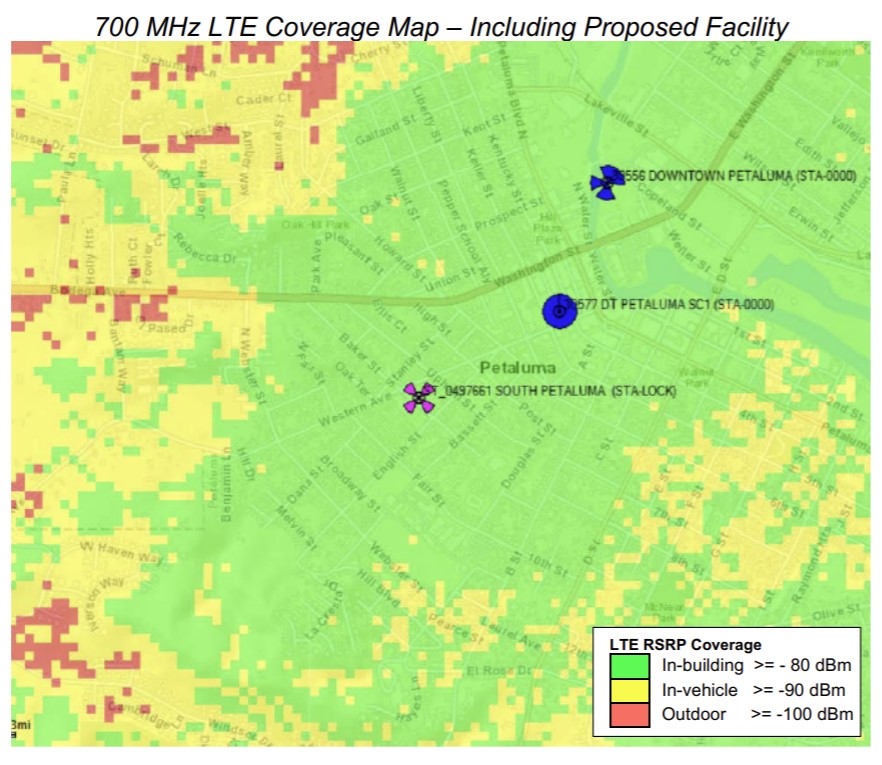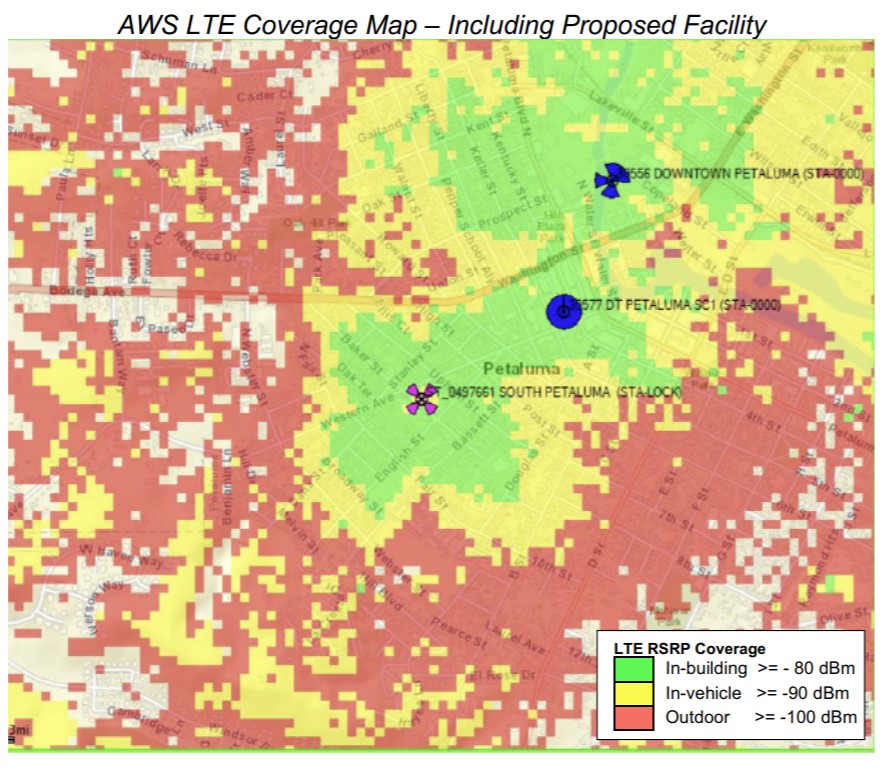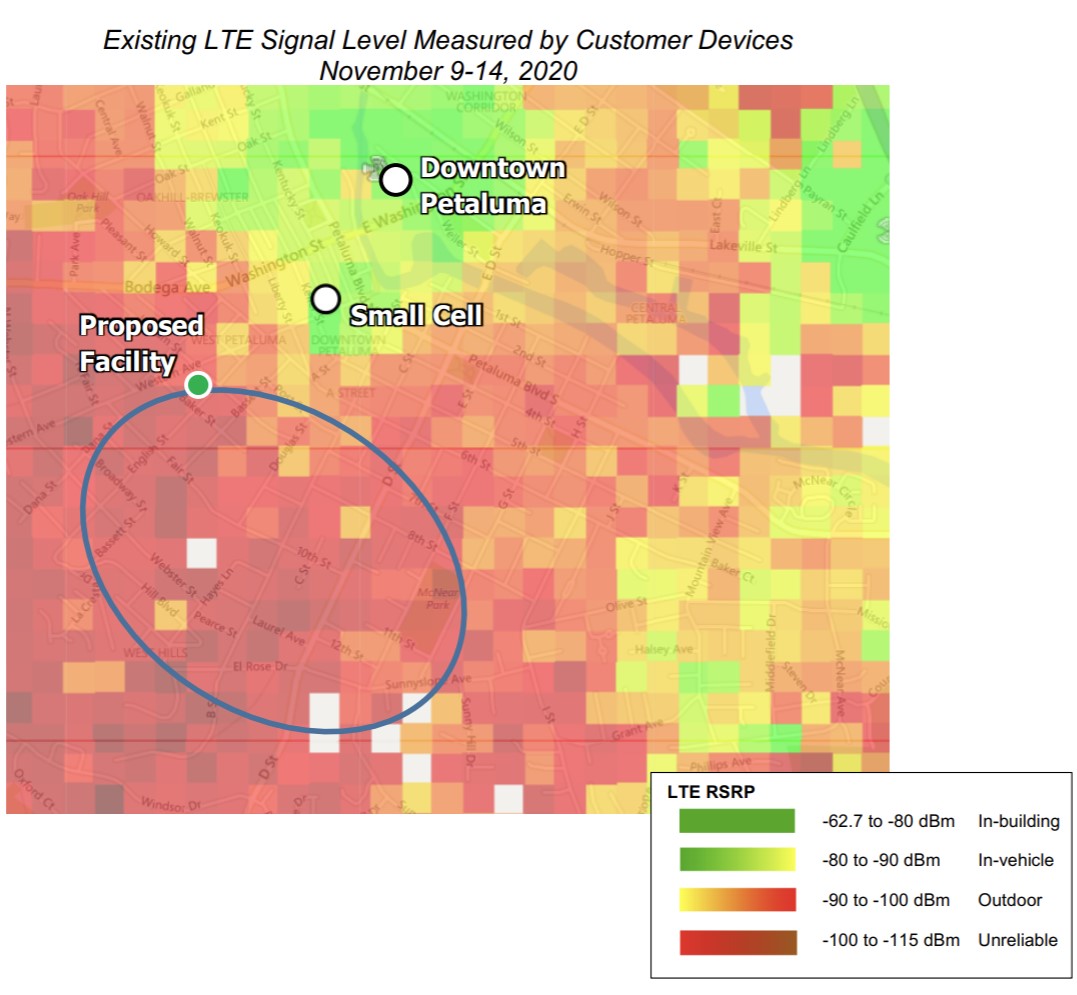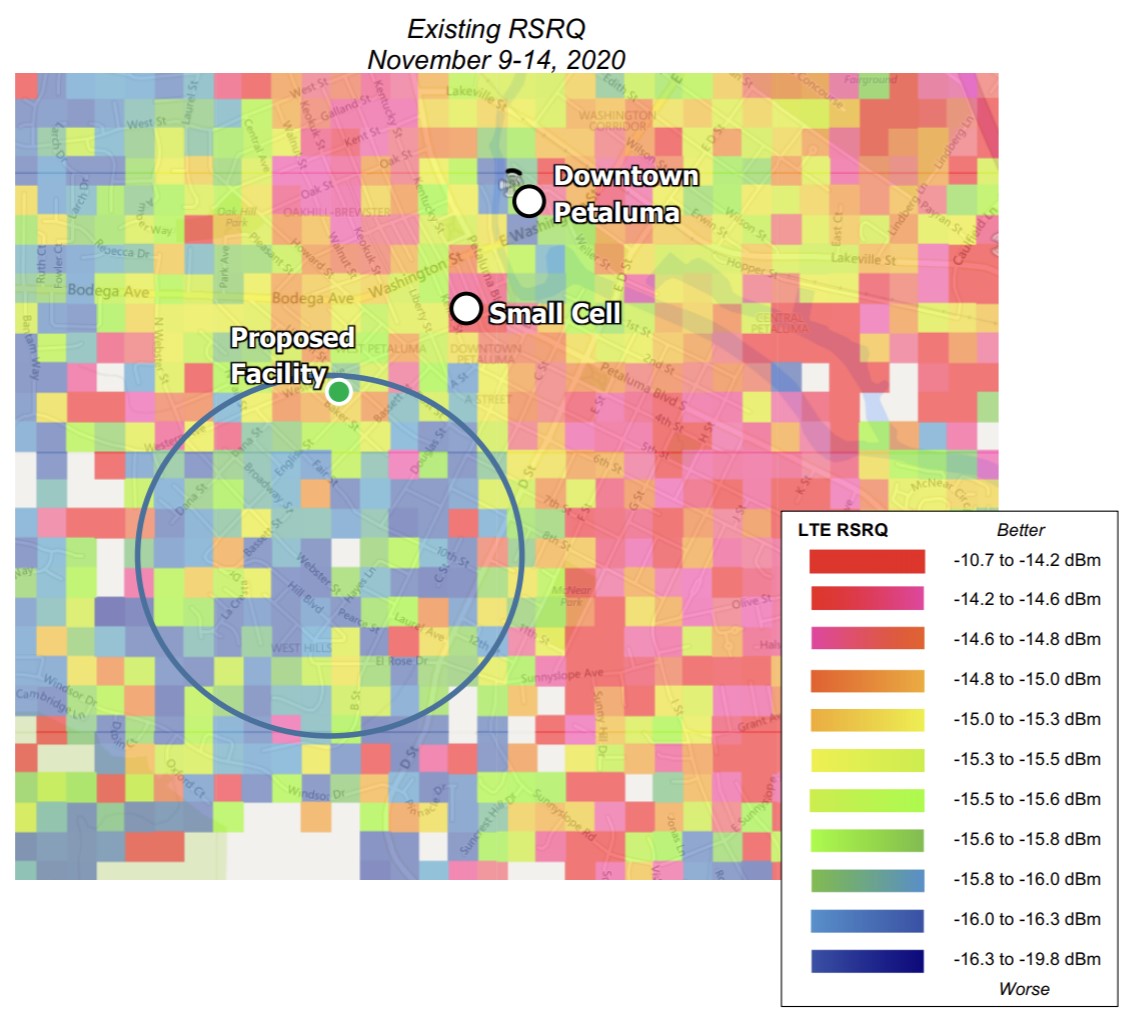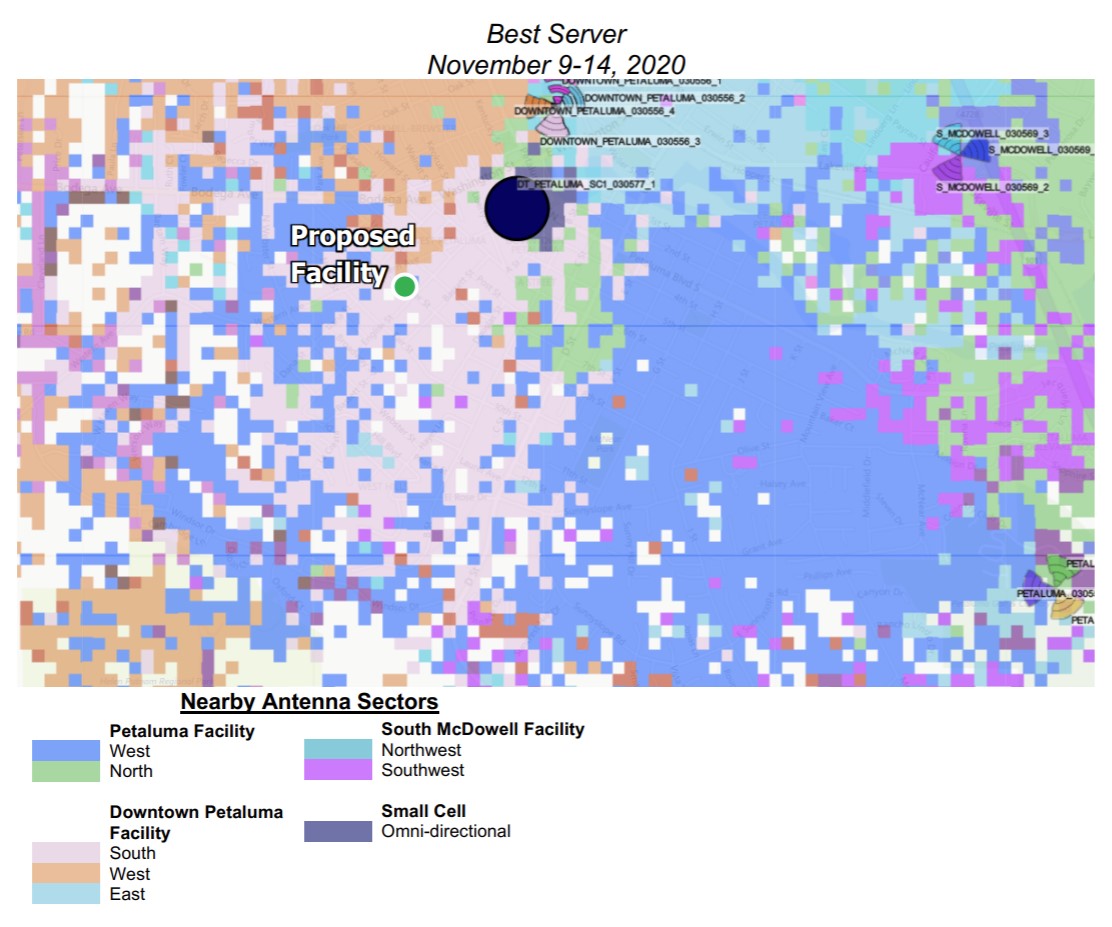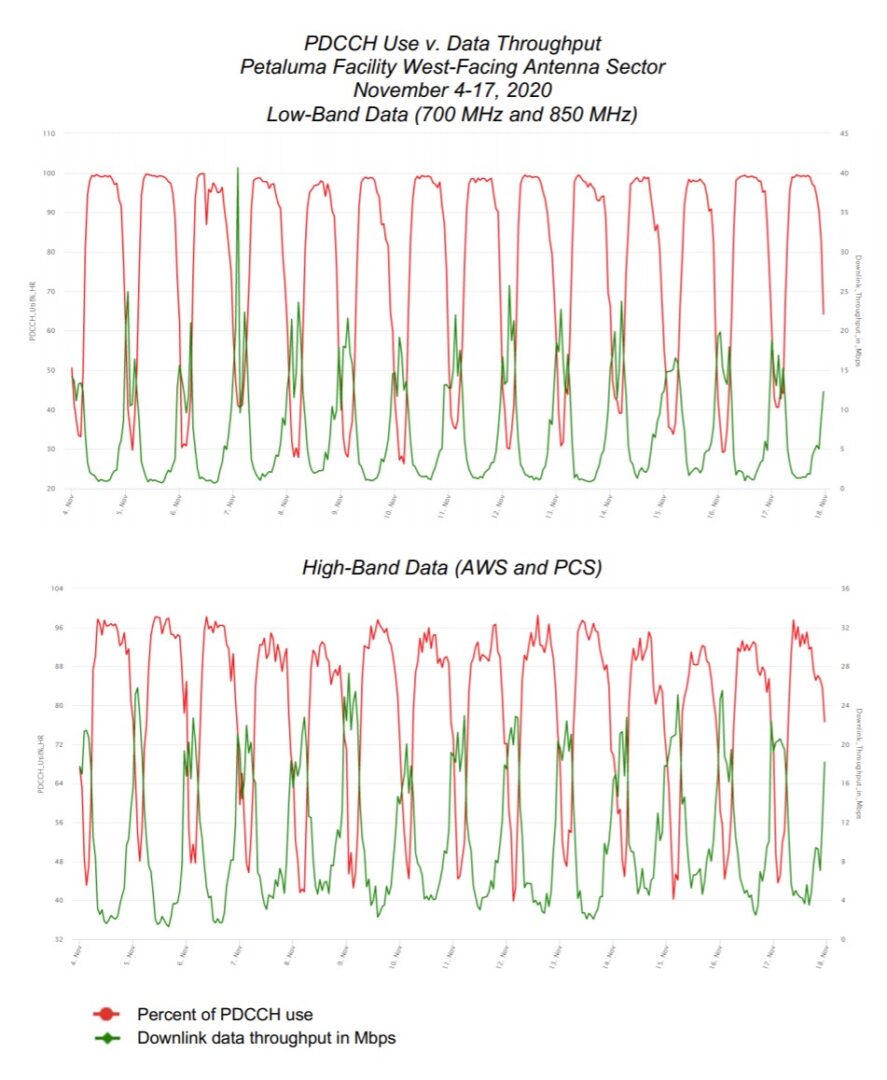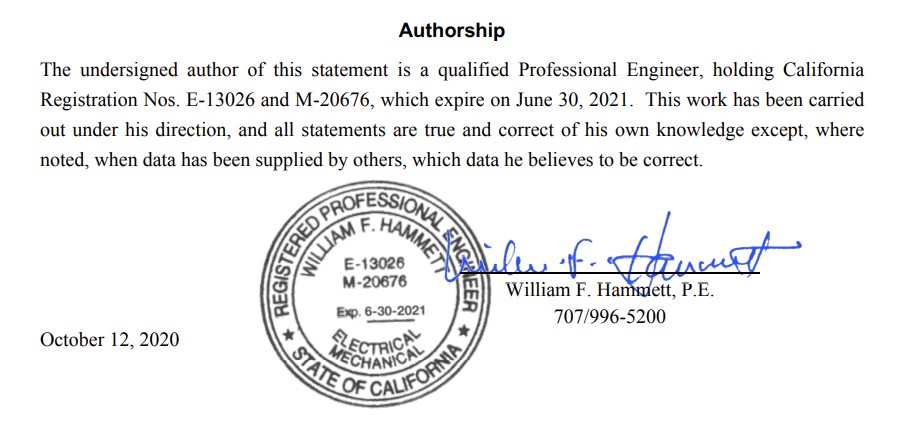Verizon Licensed Frequencies/Bands in Petaluma, CA
Updated on Dec 19, 2020
From https://www.unsafeatanyg.com/petaluma/creamery/#signal
Source: https://specmap.sequence-omega.net/
| Label | Num | Blk | Area | Channel | Bandwidth | Center | Trs./Rec. |
|---|---|---|---|---|---|---|---|
| 700 MHz | 3141 | C | REA | 746-757 | 11 | 751.5 | tbd |
| 700 MHz | 3141 | C | REA | 776-787 | 11 | 781.5 | tbd |
| Cellular | 1933 | B | CMA | 835-845 | 10 | 840 | tbd |
| Cellular | 1933 | B | CMA | 846.5-849 | 2.5 | 847.75 | tbd |
| Cellular | 1933 | B | CMA | 880-894 | 14 | 887 | tbd |
| Cellular | 1933 | B | CMA | 891.5-894 | 2.5 | 892.75 | tbd |
| PCS | 1028 | C | BTA | 1895-1910 | 15 | 1902.5 | tbd |
| PCS | 1028 | C | BTA | 1975-1990 | 15 | 1982.5 | tbd |
| AWS | 2469 | B | BEA | 1720-1730 | 10 | 1725 | tbd |
| AWS | 2469 | B | BEA | 2120-2130 | 10 | 2125 | tbd |
| AWS-3 | 678 | J | BEA | 1770-1780 | 5 | 1757.5 | tbd |
| AWS-3 | 678 | J | BEA | 2170-2180 | 5 | 2157.5 | tbd |
| CBRS PAL | 32 | P1 | PEA | 3550-3650 | 100 | 3600 | coming |
| CBRS PAL | 54 | P2 | PEA | 3550-3650 | 100 | 3600 | coming |
| CBRS PAL | 205 | P3 | PEA | 3550-3650 | 100 | 3600 | coming |
| CBRS PAL | 226 | P4 | PEA | 3550-3650 | 100 | 3600 | coming |
| CBRS PAL | 209 | P5 | PEA | 3550-3650 | 100 | 3600 | coming |
| CBRS PAL | 122 | P6 | PEA | 3550-3650 | 100 | 3600 | coming |
| mmWave | 1699 | L1 | BTA | 27500-27925 | 425 | 27712.5 | tbd |
| mmWave | 1618 | L2 | BTA | 27925-28350 | 425 | 28137.5 | tbd |
| mmWave | 3142 | M1 | PEA | 37600-37700 | 100 | 37650 | tbd |
| mmWave | 3142 | M2 | PEA | 37700-37800 | 100 | 37750 | tbd |
| mmWave | 3142 | M3 | PEA | 37800-37900 | 100 | 37850 | tbd |
| mmWave | 3142 | M4 | PEA | 37900-38000 | 100 | 37950 | tbd |
| mmWave | 3142 | M5 | PEA | 38000-38100 | 100 | 38050 | tbd |
| mmWave | 3142 | M6 | PEA | 38100-38200 | 100 | 38150 | tbd |
| mmWave | 3142 | M7 | PEA | 38200-38300 | 100 | 38250 | tbd |
| mmWave | 3132 | M8 | PEA | 38300-38400 | 100 | 38350 | tbd |
| mmWave | 2894 | M9 | PEA | 38400-38500 | 100 | 38450 | tbd |
| mmWave | 2894 | M10 | PEA | 38500-38600 | 100 | 38550 | tbd |
| mmWave | 371 | M10 | PEA | 38500-38600 | 100 | 38550 | tbd |
CA Supreme Court Ruling in T-Mobile v San Francisco (2019)
p. 8-9
. . . the City has inherent local police power to determine the appropriate uses of land within its jurisdiction. That power includes the authority to establish aesthetic conditions for land use . . . We also disagree with plaintiffs’ contention that section 7901’s incommode clause limits their right to construct [telephone] lines only if the installed lines and equipment would obstruct the path of travel. Contrary to plaintiffs’ argument, the incommode clause need not be read so narrowly.
As the Court of Appeal noted, the word “ ‘incommode’ ” means “ ‘to give inconvenience or distress to: disturb.’ ” (T-Mobile West, supra, 3 Cal.App.5th at p. 351, citing Merriam-Webster Online Dict., available at http://www.merriam-webster.com/dictionary/incommode [as of April 3, 2019].)8 The Court of Appeal also quoted the definition of “incommode” from the 1828 version of Webster’s Dictionary. Under that definition, “incommode” means “ ‘[t]o give inconvenience to; to give trouble to; to disturb or molest in the quiet enjoyment of something, or in the facility of acquisition.’”
For our purposes, it is sufficient to state that the meaning of incommode has not changed meaningfully since section 7901’s enactment. Obstructing the path of travel is one way that telephone lines could disturb or give inconvenience to public road use. But travel is not the sole use of public roads; other uses may be incommoded beyond the obstruction of travel. (T-Mobile West, at pp. 355-356.) For example, lines or equipment might
- generate noise,
- cause negative health consequences, or
- create safety concerns.
All these impacts could disturb public road use, or disturb its quiet enjoyment.
Verizon RF Statement for Petaluma Creamery, Annotated
Annotated Excerpts from this file.
Date: Dec 4, 2020
Tiwari: Snehil Tiwari, Radio Frequency Design Engineer, Verizon Wireless Network Engineering Department
Tiwari: Verizon Wireless has identified a significant gap in its fourth-generation (4G) longterm evolution (LTE) service in the south Petaluma area.
Title 47 U.S. Code §153 Definitions
(50) Telecommunications — The term “telecommunications” means the transmission, between or among points specified by the user, of information of the user’s choosing, without change in the form or content of the information as sent and received.
(53) Telecommunications service — The term “telecommunications service” means the offering of telecommunications for a fee directly to the public, or to such classes of users as to be effectively available directly to the public, regardless of the facilities used.
(24) Information service — The term “information service” means the offering of a capability for generating, acquiring, storing, transforming, processing, retrieving, utilizing, or making available information via telecommunications, and includes electronic publishing, but does not include any use of any such capability for the management, control, or operation of a telecommunications system or the management of a telecommunications service.
2005 Ninth Circuit Ruling : Metro-PCS vs. San Francisco (link)
D. Prohibition Claim
2. Service Gap(a) Definition of “Significant Gap.” Having considered both the avowed policy goals of the 1996-TCA and the practical implications of the various constructional options, we elect to follow the district court’s lead and formally adopt the First Circuit’s rule that a significant gap in service (and thus an effective prohibition of service) exists whenever a provider is prevented from filling a significant gap in its own service coverage.
(b) Least Intrusive Means: The Second and Third Circuit “least intrusive” standard . . . allows for a meaningful comparison of alternative sites before the siting application process is needlessly repeated. It also gives providers an incentive to choose the least intrusive site in their first siting applications, and it promises to ultimately identify the best solution for the community, not merely the last one remaining after a series of application denials. For these reasons, we now adopt the “least intrusive means” standard and instruct the district court to apply this rule as necessary in its consideration of the prohibition issue.
Tiwari: This area currently receives inadequate LTE service coverage from existing Verizon Wireless macro facilities
- the Downtown Petaluma facility 0.6 miles northeast
- the South McDowell facility 1.5 miles east, the Petaluma facility 1.9 miles southeast,
- and the West Petaluma facility 2.1 miles northwest.
Tiwari: A small cell facility recently installed on Kentucky Street downtown, 0.35 miles east, provides targeted service to the downtown area only.
From the Nov 15, 2020 Federal Registry entry:
Small wireless facilities are facilities that meet each of the following conditions:
(1) The facilities –
(i) Are mounted on structures 50 feet or less in height including their antennas as defined in § 1.1320(d); or
(ii) Are mounted on structures no more than 10 percent taller than other adjacent structures; or
(iii) Do not extend existing structures on which they are located to a height of more than 50 feet or by more than 10 percent, whichever is greater;
(2) Each antenna associated with the deployment, excluding associated antenna equipment (as defined in the definition of antenna in § 1.1320(d)), is no more than three cubic feet in volume;
(3) All other wireless equipment associated with the structure, including the wireless equipment associated with the antenna and any pre-existing associated equipment on the structure, is no more than 28 cubic feet in volume;
(4) The facilities do not require antenna structure registration under part 17 of this chapter;
(5) The facilities are not located on Tribal lands, as defined under 36 CFR 800.16(x); and
(6) The facilities do not result in human exposure to radiofrequency radiation in excess of the applicable safety standards specified in § 1.1307(b).
Tiwari: there is a gap in reliable LTE in-building service coverage in the south Petaluma area, west of downtown.
Tiwari: There is a lack of dominant signal in the gap area, which compromises signal quality for customer handsets and degrades network performance.
Tiwari: In the Petaluma area,
- 60% of Verizon Wireless’s LTE bandwidth is in 2,100 MHz (Advanced Wireless Service or AWS) and 1900 MHz (Personal Communications Service or PCS)
- 40% of Verizon Wireless’s LTE bandwidth is in 700 MHz and 850 MHz.
A bandwidth chart appears below. Higher frequencies mean greater data capacity.
Verizon Wireless Spectrum in Petaluma Area
| Band | Frequency | LTE Bandwidth | % of total bandwidth |
|---|---|---|---|
| 700 MHz | 700 MHz | 10 MHz | 20% |
| 850 MHz | 850 MHz | 10 MHz | 20% |
| PCS | 1900 MHz | 10 MHz | 20% |
| AWS | 2100 MHz | 20 MHz | 40% |
Verizon Licensed Low- & Mid-Band Freqs/Bands/Channels in Petaluma, CA
Updated on Dec 19, 2020
From https://www.unsafeatanyg.com/petaluma/creamery/#signal
Source: https://specmap.sequence-omega.net/
| Label | Num | Blk | Area | Channel | Bandwidth | Center | Trs./Rec. |
|---|---|---|---|---|---|---|---|
| 700 MHz | 3141 | C | REA | 746-757 | 11 | 751.5 | tbd |
| 700 MHz | 3141 | C | REA | 776-787 | 11 | 781.5 | tbd |
| Cellular | 1933 | B | CMA | 835-845 | 10 | 840 | tbd |
| Cellular | 1933 | B | CMA | 846.5-849 | 2.5 | 847.75 | tbd |
| Cellular | 1933 | B | CMA | 880-894 | 14 | 887 | tbd |
| Cellular | 1933 | B | CMA | 891.5-894 | 2.5 | 892.75 | tbd |
| PCS | 1028 | C | BTA | 1895-1910 | 15 | 1902.5 | tbd |
| PCS | 1028 | C | BTA | 1975-1990 | 15 | 1982.5 | tbd |
| AWS | 2469 | B | BEA | 1720-1730 | 10 | 1725 | tbd |
| AWS | 2469 | B | BEA | 2120-2130 | 10 | 2125 | tbd |
| AWS-3 | 678 | J | BEA | 1770-1780 | 5 | 1757.5 | tbd |
| AWS-3 | 678 | J | BEA | 2170-2180 | 5 | 2157.5 | tbd |
Verizon Licensed Mid- & High-Band Freqs/Bands/Channels in Petaluma, CA
Updated on Dec 19, 2020
| Label | Num | Blk | Area | Channel | Bandwidth | Center | Trs./Rec. |
|---|---|---|---|---|---|---|---|
| CBRS PAL | 32 | P1 | PEA | 3550-3650 | 100 | 3600 | coming |
| CBRS PAL | 54 | P2 | PEA | 3550-3650 | 100 | 3600 | coming |
| CBRS PAL | 205 | P3 | PEA | 3550-3650 | 100 | 3600 | coming |
| CBRS PAL | 226 | P4 | PEA | 3550-3650 | 100 | 3600 | coming |
| CBRS PAL | 209 | P5 | PEA | 3550-3650 | 100 | 3600 | coming |
| CBRS PAL | 122 | P6 | PEA | 3550-3650 | 100 | 3600 | coming |
| mmWave | 1699 | L1 | BTA | 27500-27925 | 425 | 27712.5 | tbd |
| mmWave | 1618 | L2 | BTA | 27925-28350 | 425 | 28137.5 | tbd |
| mmWave | 3142 | M1 | PEA | 37600-37700 | 100 | 37650 | tbd |
| mmWave | 3142 | M2 | PEA | 37700-37800 | 100 | 37750 | tbd |
| mmWave | 3142 | M3 | PEA | 37800-37900 | 100 | 37850 | tbd |
| mmWave | 3142 | M4 | PEA | 37900-38000 | 100 | 37950 | tbd |
| mmWave | 3142 | M5 | PEA | 38000-38100 | 100 | 38050 | tbd |
| mmWave | 3142 | M6 | PEA | 38100-38200 | 100 | 38150 | tbd |
| mmWave | 3142 | M7 | PEA | 38200-38300 | 100 | 38250 | tbd |
| mmWave | 3132 | M8 | PEA | 38300-38400 | 100 | 38350 | tbd |
| mmWave | 2894 | M9 | PEA | 38400-38500 | 100 | 38450 | tbd |
| mmWave | 2894 | M10 | PEA | 38500-38600 | 100 | 38550 | tbd |
| mmWave | 371 | M10 | PEA | 38500-38600 | 100 | 38550 | tbd |
Tiwari: The Proposed Facility will provide new reliable LTE in-building coverage to these areas, with a population of 1,870 residents.
The following coverage maps show existing and proposed coverage for each of the 700 MHz, 850 MHz, 1,900 MHz and 2,100 MHz and frequencies.
- The 700 MHz and 850 MHz bands have similar propagation characteristics,
- The 1,900 MHz and 2,100 MHz bands have similar propagation characteristics
The maps are prepared using Verizon Wireless’s [proprietary] Atoll tool.
Reference signal received power (RSRP) is a measurement of signal level in decibel-milliWatts (dBm), which is a negative number that decreases with increased distance.
The LTE RSRP coverage labels [as selected by Tiwari] are [cherry-picked as]:
- >= -80 dBm Green depicts good coverage that meets or exceeds thresholds for reliable network coverage in homes and vehicles.
- >= -90 dBm Yellow depicts reliable in-vehicle coverage.
- >= -100 dBm Red depicts reliable outdoor service.
dBm (decibel-milliwatts) is an abbreviation for the power ratio in decibels (dB) of the measured power referenced to one milliwatt (1 mW = 1/1,000 of a Watt). It is used in radio, microwave and fiber-optic communication networks as a convenient measure of absolute power because of its capability to express both very large and very small values in a short form. The following data is based on that published in the Cornet ED-85X Manual; the meter’s antenna is centered at 2,450 MHz and can meter RF Microwave Radiation from 700 MHz to 6,000 MHz.
As explained here, ALL of the dBm signal strength levels listed in the Relevant Signal Strength Levels table, below, should appear on any accurate signal strength projection, so one can evaluate where the signal strength is higher than needed, given that Section 324 of the 1996 Telecommunications Act (“1996-TCA”) applies to Wireless Telecommunications Facilities (WTFs) of any size and any “G”, per an Oct 19, 2020 call with by Ms. Garnet Hanly, Division Chief of the Competition & Infrastructure Policy Division, FCC Wireless Telecommunications Bureau.
From this web page one can read:
47 U.S. Code § 324 – Use of minimum power
“In all circumstances . . . all radio stations . . . shall use the minimum amount of power necessary to carry out the communication desired.”
We already know the communication desired is “personal wireless services”, which is defined in the 1996 Telecommunications Act (1996-TCA) as:
§332(a)(7)(C)(ii)
“the term ‘personal wireless services’ means commercial mobile services, unlicensed wireless services, and common carrier wireless exchange access services”
. . . which translates to wireless phone calls, Wi-Fi and connecting to legacy copper switched telephone landlines. There is no mention at all of wireless broadband (internet, video and gaming) service, which means there is no preemption at all for wireless broadband services in the 1996-TCA.
The two key preemptions of local authority are the following:
§332(a)(7)(B)(i)
“(I) shall not unreasonably discriminate among providers of functionally equivalent services; and
(II) shall not prohibit or have the effect of prohibiting the provision of personal wireless services.”
We have already read the definintion of personal wireless services, but it is important to note that functionally equivalent services are only personal wireless services — they do not include wireless broadband services — as clarified by the 1996-TCA Conference report that was recognized as the law of the land (meaning it applies to every US State) by the US Supreme Court in its 2005 Ruling in Palos Verdes v Abrams
The 1996-TCA Conference Report says the following:
“When utilizing the term “functionally equivalent services” the conferees are referring only to personal wireless services as defined in this section that directly compete against one another.”
Relevant Signal Strength Levels, Ignored in Wireless Co. Projections
Customers can make Verizon wireless phone calls at ALL of the dBm Signal Strength levels, listed below.
| dBm | Avg. Power Density | Compared to “5-bars” Signal Stength |
|---|---|---|
| 0 dBm | 580,000 µW/m² | 322,000,000x higher |
| -5 dBm | 180,000 µW/m² | 100,000,000x higher |
| -10 dBm | 58,000 µW/m² | |
| -15 dBm | 18,000 µW/m² | 10,000,000x higher |
| -20 dBm | 5,800 µW/m² | |
| -25 dBm | 1,800 µW/m² | 1,000,000x higher |
| -30 dBm | 580 µW/m² | |
| -35 dBm | 180 µW/m² | 100,000x higher |
| -40 dBm | 58 µW/m² | |
| -45 dBm | 18 µW/m² | 10,000x higher |
| -50 dBm | 5.8 µW/m² | |
| -55 dBm | 1.8 µW/m² | 1,000x higher |
| -60 dBm | 0.58 µW/m² | |
| -65 dBm | 0.18 µW/m² | 100x higher |
| -70 dBm | .058 µW/m² | |
| -75 dBm | .018 µW/m² | 10x higher |
| -80 dBm | .0058 µW/m² | |
| -85 dBm | 0.0018 µW/m² | 5 Bars on a cell phone |
| -90 dBm | 0.00058 µW/m² | |
| -95 dBm | 0.00018 µW/m² | 1/10 lower |
| -100 dBm | 0.000058 µW/m² | |
| -105 dBm | 0.000018 µW/m² | 1/100 lower |
| -110 dBm | 0.0000058 µW/m² | |
| -115 dBm | 0.0000018 µW/m² | 1/1,000 lower |
| -120 dBm | 0.00000058 µW/m² | |
| -125 dBm | 0.00000018 µW/m² | 1/10,000 lower |
[stopped here at 10:00 am]
Hammett & Edison RF Report
Annotated Excerpts from this file.
Date: Oct 12, 2020
Hammett: William F. Hammett, PE/owner of Hammett & Edison
Hammett: Site and Facility Description Based upon information provided by Verizon, including zoning drawings by MST Architects, Inc., dated September 18, 2020, it is proposed to install sixteen CommScope Model NHH-45B directional panel antennas within four cylindrical enclosures to be mounted above the roof of the tallest building section of the Petaluma Creamery, located at 611 Western Avenue in Petaluma. The antennas would employ up to 13° downtilt, would be mounted at an effective height of about 66½ feet above ground, 6½ feet above the roof, and would be oriented in groups of four toward 0°T, 90°T, 180°T, and 270°T, to provide service in all directions. The maximum effective radiated power in any direction would be 46,800 watts, representing simultaneous operation at 18,350 watts for AWS, 10,000 watts for PCS, 9,940 watts for cellular, and 8,510 watts for 700 MHz service. There are reported no other wireless telecommunications base stations at the site or nearby.
Study Results
Hammett: For a person anywhere at ground, the maximum RF exposure level due to the proposed Verizon operation is calculated to be 0.12 mW/cm2, which is 22% of the applicable public exposure limit. The maximum calculated level at the second-floor elevation of any nearby building* is 31% of the public exposure limit. The maximum calculated level at the second-floor elevation of any nearby residence† is 24% of the public limit. It should be noted that these results include several “worst-case” assumptions and therefore are expected to overstate actual power density levels from the proposed operation. Levels are calculated to exceed the applicable exposure limits on the roof of the subject building, in front of the antennas.
Recommended Mitigation Measures
Hammett: It is recommended that the roof access hatch be kept locked, so that the Verizon antennas are not accessible to unauthorized persons. To prevent occupational exposures in excess of the FCC guidelines, it is recommended that appropriate RF safety training, to include review of personal monitor use and lockout/tagout procedures, be provided to all authorized personnel who have access to the roof, including employees and contractors of Verizon and of the property owner. No access within 62 feet directly in front of the Verizon antennas themselves, such as might occur during certain maintenance activities on the roof of the building, should be allowed while the pertinent antennas are in operation, unless other measures can be demonstrated to ensure that occupational protection requirements are met. It is recommended that boundary lines be marked on the roof with yellow and orange paint, to identify areas within which exposure levels are calculated to exceed the FCC occupational limit and to exceed that limit by 10 times, respectively, as shown in Figure 3. It is recommended that explanatory signs‡ be posted at the roof access hatch, at the boundary lines, and on the cylindrical enclosures in front of the antennas, readily visible from any angle of approach to persons who might need to work within that distance.
- [1] Specifically, the two-story building to the south across Baker Street, about 100 feet away, based on photographs from Google Maps.
- [2] Specifically, the residences to the northwest across Western Avenue, at least 200 feet away, based on photographs from Google Maps.
- [3] Signs should comply with OET-65 color, symbol, and content recommendations. Contact information should be provided (e.g., a telephone number) to arrange for access to restricted areas. The selection of language(s) is not an engineering matter, and guidance from the landlord, local zoning or health authority, or appropriate professionals may be required.
Conclusion
Based on the information and analysis above, it is the undersigned’s professional opinion that operation of the base station proposed by Verizon Wireless at 611 Western Avenue in Petaluma, California, can comply with the prevailing standards for limiting human exposure to radio frequency energy and, therefore, need not for this reason cause a significant impact on the environment. The highest calculated level in publicly accessible areas is much less than the prevailing standards allow for exposures of unlimited duration. This finding is consistent with measurements of actual exposure conditions taken at other operating base stations. Locking the roof access hatch is recommended to establish compliance with public exposure limits; training authorized personnel, marking roof areas, and posting explanatory signs are recommended to establish compliance with occupational exposure limits.
